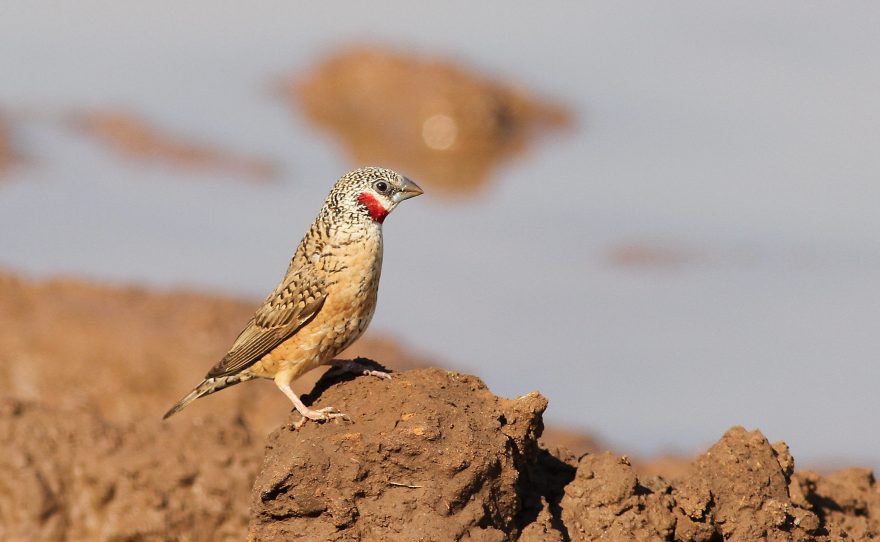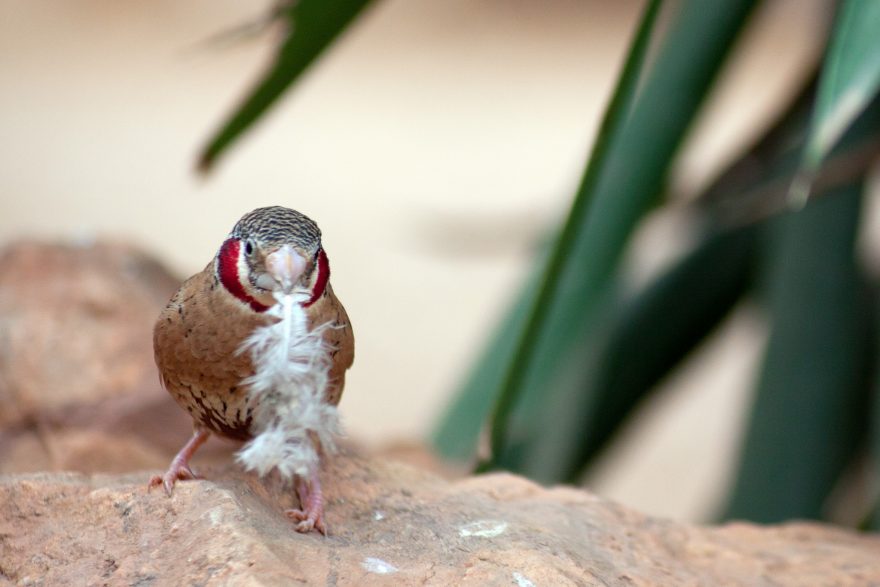The cut-throat finch, also known as the bearded finch or the ribbon finch, is a common species of estrildid finch predominantly found in sub-Saharan Africa. They are reasonably popular in aviculture thanks to their unusual appearance and the ease at which they’re bred.

Housing & Compatibility
Cut-throat finches can be housed as single pairs, a colony, or as part of a mixed collection. When more than one pair is housed in a single aviary, it’s important to ensure there’s an even number of males and females, or else aggression from unpaired birds may become problematic.
Cut-throat finches can be assertive to smaller finches, so it’s important to choose their aviary companions wisely. Providing a large, sparsely-populated aviary with plenty of hiding places is the best way to manage their aggression.
Cut-throat finches will hybridize with the Aberdeen finch. They should not be housed together or in adjoining aviaries where contact is possible.
Diet & Feeding
A quality seed mix including canary seed, various millets and panicum forms the basis of the cut-throat finch’s diet. Seed lacks many essential vitamins and minerals which must be compensated for by introducing other foods. Sprouting seed increases its nutritional value and is a cheap way to improve your bird’s health. Freshly grown green seed heads should also be offered frequently.
Some leafy greens should be provided throughout the year. Kale, bok choy, endive and silverbeet are the most nutritious and will be readily eaten. Spinach can also be given, but only sparingly as it can contribute to calcium deficiency.
Live food is an important component of the cut throat finch’s diet and should be provided throughout the year – especially during the breeding season. Mealworms, maggots, termites, and small crickets will be consumed readily. Commercial soft finch food mixes can also be provided for an added nutrient boost, particularly when breeding.
Do not feed anything from the list of forbidden foods.

Breeding
Cut-throat finches breed best in spring and autumn, with a hen bird that is at least 12 months of age.
In the wild, cut-throat finches often take over the nests from other birds. Because of this, many pairs will be poor nest builders who need a little assistance from humans. A handful of grass shaped into a ring and stuffed inside a nesting receptacle is enough to get them started.
A wide variety of artificial nests will be accepted, however they tend to prefer a medium-sized commercial cane nest. They will not re-use a nest, so multiple receptacles need to be provided. Cut-throat finches will tolerate nest inspections, but they should be avoided unless absolutely necessary.
They typically lay 3-5 eggs in each clutch, which are incubated by both parents for approximately 14 days. Young birds fledge the nest at three weeks of age and are usually independent about three weeks later. In cages and small aviaries it’s necessary to remove the young birds from the aviary once they become independent, especially if the parents are to continue breeding.
Sexing
Cut-throat finches are easy to visually sex once they’ve reached maturity. Only the males have the distinctive red band across the throat.
Mutations
Cut-throat finch mutations are quite rare. Birds with yellow throats—instead of the usual red—pop up occasionally. More rare is a white (likely albino) mutation, which presents as a purely white bird with a red throat.
Health
A strict worming and parasite control regime is essential to ensure the long-term health of any finch collection. Cut-throat finches can be expected to live for 8-10 years.
Cut-throat finches will spend a lot of time foraging for insects on the aviary floor, making them more susceptible to parasites and diseases that spread via droppings. Regular cleaning and preventative healthcare is a must.